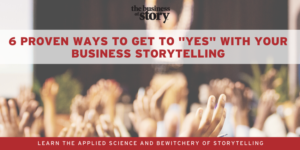(The following article originally ran in Sustainable Brands news)
Park Howell, president of Phoenix-based brand strategy and marketing firm Park&Co, also heads the Communications thread of the Arizona State University School of Sustainability’s Executive Master’s for Sustainability Leadership (EMSL) program. Under Howell’s direction, the program replaces communications theory with “communications commandos.”
We spoke with Howell about tapping into our innate storytelling instinct and how the Story Cycle can be utilized by brands in their marketing efforts and by sustainability executives to enact change within their organizations.
AL: The goal of the EMSL’s Communications thread is “to create the communications course with the goal of developing Chief Storyteller Officers out of sustainability executives.” What does it really mean to be a Chief Storyteller Officer and why is it especially important for sustainability executives?
PH: When we were in the first throes of setting up the ESLM program, I overheard John Davies of Greenbiz say in a working group that the real, true role of a sustainability executive is to be a Chief Translation Officer, to translate what sustainability really means to the bottom line, to operational capacity, to people. I loved that! I just wanted to take it farther.
What I try to remind and encourage sustainability professionals everyday is that the numbers, the metrics, the data, the charts, and the Powerpoints are almost meaningless in the minds of the audience. The numbers are important and they are important to the story, but they are not the story. Our job is to really give meaning to that data and turn data into drama by using good, old-fashioned story structure created from the beginning of time, underscored by Joseph Campbell in the Hero’s Journey, which has led to our work, a hybrid of his work that we call the Story Cycle.
We take our students and our clients through the Story Cycle’s 10-step process and help them with high-level strategy, one-on-one communication and everything in between.
AL: One of the steps in the Story Cycle is “Building Ritual.” So much of making sustainability initiatives work is going beyond imparting knowledge and actuallyfacilitating behavior change. Most people know they should recycle, bring reusable bags to store, etc. but actually doing it somehow doesn’t “stick.” Can you talk more about “Building Ritual” and how it may be used by sustainability executives?
PH: Yes. Somehow we’ve got to make this “stick.” Bottom line. Park & Co created and launched a water-conservation campaign in 1999 and it grew exponentially. By the end, we had over 400 private and public entities using the campaign. We labeled commonly used products as “water-saving devices.” For example, we labeled toothbrushes “Water Saving Device #53,” which begged the question, “How is a toothbrush saving water?” Then people would participate in the story by reading that when you turn the water off while you brush your teeth, you’ll save five gallons every time or 80 gallons every week.
We labeled 150 different products and had a lot of fun creating informative visuals around the point of use. We found that we were able to create environmental prompts for everything from toothbrushes, brooms, mops and pliers, to things you normally would not associate with water. The idea behind our program was to build ritual around every time the faucet was turned on. You would think to yourself, even subconsciously, “I’m using water.” We realized that when we could build ritual around the tap, we could have people turn it off more readily.
We also learned the single most valuable lesson I’ve learned in storytelling: Show, don’t tell. Don’t just advertise a mandate to save water — show how.
That’s what I like about the ELKAY water bottle refill stations that have a ticker showing the number of plastic water bottles saved from going to landfills. They’re building out a ritual of educating consumers about plastic bottle waste every time they’re filling their own water bottles, to the point where they’re thinking about it even when they’re filling at other places.
Another great way of building ritual is redefining rules. Levi’s did a really cool campaign with Goodwill. Levi’s created clothing tags with 4 steps: machine wash with like colors, tumble dry medium, warm iron if needed, and the final one, that I love — donate to Goodwill when no longer needed and care for our planet. They’re building a ritual out of not just throwing clothing away, but donating it to a worthy cause.
AL: What are some of the common pitfalls that occur in trying to adopt storytelling in communicating sustainability?
PH: I think one of the common pitfalls deals with authenticity. I see groups that end up telling a really great story, but it’s not always terribly truthful. I think that bites them in the ass faster than anything. Or the consumer can tell they are telling the truth, but the subtext is really just to sell something. There’s a really good example of this that drives me crazy. Last fall, the American Beverage Association and the International Bottled Water Association launched this campaign to get more children to drink more water, instead of sugary soda. A noble cause. However, it doesn’t address landfill blight caused by plastic bottles. I just found the whole campaign extraordinarily disingenuous.
I also find McDonald’s sponsorship of the Olympics disingenuous on both parts. I find it disingenuous of McDonald’s suggesting that you’d buy healthy food there (when you know that’s not why people go there). And I find it disingenuous of the Olympics to claim this is a “breakfast of champions.” Those kinds of stories are very powerful, but they don’t sit well with consumers. Consumers are smarter than that and in this day and age, they are just getting smarter. If you are going to wield the powerful sword of storytelling, you better be doing it with authenticity.
Storytelling is so powerful and so universal that when it is done well, for good or bad intentions, it can be extraordinarily effective. If a sustainability officer or program is not completely authentic and honest, they will reveal themselves very quickly through storytelling.
AL: You’ve said, “We were at our best in kindergarten” and that the skill of storytelling has been educated out of us. Where do you turn for inspiration when you’re feeling the need for a creative nudge?
PH: You know where’s the greatest place in the world to get a creative nudge? Listen to NPR’s Storycorps. You can listen to short, 2- to 3-minute stories shared by anonymous citizens of America, people who you wouldn’t expect to have a story, and yet they always tell the most amazing stories. When people tell me they don’t have a story to tell, I send them to NPR’s website and listen to 2 or 3 stories and see if it doesn’t inspire and ignite that storytelling instinct.
I really do believe everybody is an innate storyteller. It has been coached out of us and educated out of us, but it really is latent in our bodies, waiting to come out again. The Story Cycle gives people a pragmatic approach for collecting their thoughts and telling those great stories. If you have readers saying, “I can’t pull this off. I’m not that great of a storyteller,” I will challenge everyone. I do believe when you start embracing storytelling and telling stories, they will have tremendous success. And, that is what is going to help sustainability start advancing faster and farther
 Anna is an Insight Development Research Associate for Sustainable Brands. As part of the Content Team she researches trends in sustainability and assists in program development for our conferences. She brings a decade of media and community organizing experience, a… [Read more about Anna Lui]
Anna is an Insight Development Research Associate for Sustainable Brands. As part of the Content Team she researches trends in sustainability and assists in program development for our conferences. She brings a decade of media and community organizing experience, a… [Read more about Anna Lui]











